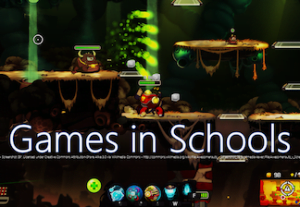Successful 1st Edition of Games in Schools MOOC
 The Massive Open Online Course (MOOC) of Games in Schools was held between the 27th October and the 31st December 2014. This course, delivered via the European Schoolnet Academy platform, saw an unexpected total of 1597 people enrolling, primarily from southern Europe, with Greece (18%), Italy (15%) and Romania (13%) as main countries. Participants from Portugal (8%), Spain (7%) and Turkey (6%) were also well represented, but the course attracted people from every single country in Europe (and beyond, with a couple of dozen participants from North and Latin America, Africa and Asia). Similarly to other Academy courses, 94% of the participants were classroom teachers with a majority working in secondary schools (63%).
The Massive Open Online Course (MOOC) of Games in Schools was held between the 27th October and the 31st December 2014. This course, delivered via the European Schoolnet Academy platform, saw an unexpected total of 1597 people enrolling, primarily from southern Europe, with Greece (18%), Italy (15%) and Romania (13%) as main countries. Participants from Portugal (8%), Spain (7%) and Turkey (6%) were also well represented, but the course attracted people from every single country in Europe (and beyond, with a couple of dozen participants from North and Latin America, Africa and Asia). Similarly to other Academy courses, 94% of the participants were classroom teachers with a majority working in secondary schools (63%).
77% of participants were female and a similar amount were over 35 years of age (76%). Furthermore, most participants had substantial experience of working in an education setting (70% had more than 11 years of experience). In regards to using games in the classroom prior to attending the course, 38% reported of rarely or never using games in the classroom while 17% reported they did so often.
Of all enrolled participants, 1280 actively engaged with the content of the course, which is an 80% engagement rate. Of these, 495 completed the final module and assessment of the course and thereby qualified for the final course certificate, providing a 39% retention rate. This is a hugely positive result given that most MOOCs have a retention rate below 13% (Jordan, Katy (2014). Initial trends in enrolment and completion of massive open online courses. International Review of Research in Open and Distance Learning, 15(1) pp. 133–160.). Also positive were the retention rates within the six Modules of the course, which varied between 71% and 90%.
Social media was actively used on the course as a tool of discussion and promotion. The official Facebook group (https://www.facebook.com/groups/gamesinschools/) consists of 850 members and is still activley used by participants to share resources and ask questions.
The positive retention rates are reflected in the positive feedback provided by the participants. 99.57% of respondents to the evaluation survey provided a positive feedback to the course. 70% rated the course with the best option of “very good” while 29% gave the course the second highest rating of a “good”. At a more granular level, the most highly rated elements of the course were the practical ideas for professional practice offered by the course as well as the clarity of the learning objectives.
In the evaluation survey participants were asked about the impact of the course on their daily classroom practice. Especially notable here is the fact that 73% report that as a result of the course they have tried out a computer game in their classroom which was previously unknown to them. Of all participants, 87% report they have adapted their teaching method as a result of the course, 61% acknowledge that they collaborate more regularly with colleagues and 81% state that they now use technology more effectively in the classroom.
At the core of the course was the discussion and sharing of ideas about games in schools. As part of this the participants engaged in very fruitful discussions around topics such as identifying non-educational commercial games that could be used in the classroom as well as how to overcome challenges of using such commercial games (e.g. cost, parent opposition, etc.). This collaboration resulted in 60 pages of concrete examples and best practices that the participants will be able to draw from in the future.
When asked about challenges they faced in using games in their classrooms, participants agreed on a number of issues, in order of importance:
- Lack of technology available in the classroom
- Too much focus on assessment, making it difficult to integrate games in everyday teaching
- Lack of budget to pay for games
- Lack of integration into national curricula
- Lack of computers in classroom
- Lack of time to experiment with new tools and pedagogies
- Lack of training for teachers
- Lack of internet access in the classroom
- Lack of rules for using students' own devices
- Lack of acceptance from colleagues
Unsurprisingly, availability of devices is a key issue as well as lack of budget to pay for games. But equally important to the teachers seem to be the challenges associated with the curricula, in particular the focus on assessment practices which do not take into account the use of games.
As the final activity, the participants developed lesson plans that incorporated the use of a game, taking into account the pedagogical principles introduced for effective use of games in schools. This resulted in close to 500 lesson plans created and shared among the community.
Overall, the first edition of the Games In Schools MOOC was a success, and Video Games Europe has already agree with European Schoolnet to do a second round of the course, which will start on the 18th of May.

